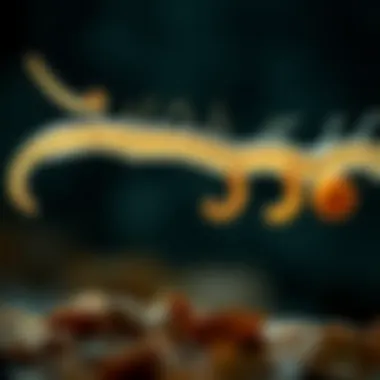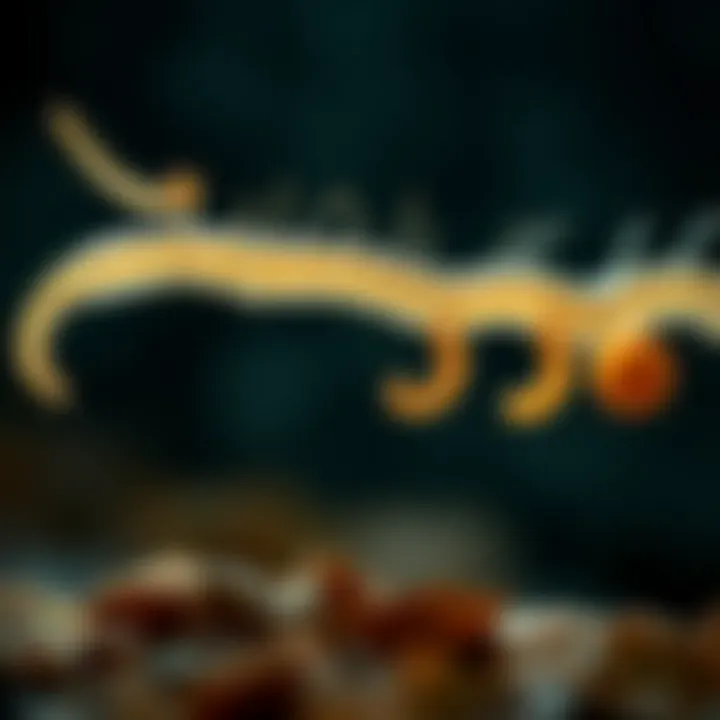In-Depth Guide to Understanding Intestinal Roundworms


Research Overview
Intestinal roundworms, belonging to the class Nematoda, pose significant health challenges worldwide. Understanding their biology, lifecycle, and transmission dynamics is crucial for devising effective public health interventions. This overview synthesizes current findings and provides a firm grounding in the complexities surrounding these organisms.
Summary of Key Findings
Research has shown that intestinal roundworms infect hundreds of millions of people globally, particularly in tropical and subtropical regions. The most notable species include Ascaris lumbricoides, Enterobius vermicularis, and Strongyloides stercoralis, each with distinct transmission routes and health impacts. The transmission typically occurs through contaminated food and water or from person to person. Symptoms can range from mild discomfort to severe health issues, depending on the infection load and individual health condition.
"Intestinal roundworms are silent invaders, often going unnoticed until they cause significant damage."
Background and Context
The history of intestinal roundworm infections dates far back in human evolution, likely co-existing with humans as they migrated and settled in diverse environments. The prevalence of these parasites is closely tied to socioeconomic factors, including sanitation and healthcare access. In regions where clean drinking water and adequate waste disposal systems are lacking, the risk of infection rises dramatically.
Moreover, specific life habits contribute to the spread of these parasites. For example, communities relying on agricultural practices often face challenges with soil-transmitted helminths due to their life cycle, which can occur in the very soil that sustains crops. Understanding these contextual elements is key to formulating effective health strategies.
Methodology
Experimental Design
Explorations into intestinal roundworm infections often employ a mixture of observational and experimental methodologies. Researchers typically gather data through surveys, clinical assessments, and laboratory analyses. These methods help delineate the prevalence of infections and their correlation with environmental and health factors.
Data Collection Techniques
Data collection frequently involves the examination of fecal samples, serological surveys, and epidemiological approaches.
- Fecal Examination: This helps in identifying the presence of roundworm eggs, indicating an active infection.
- Questionnaires: Surveys asking about symptoms, hygiene practices, and socio-economic status help identify infection trends within communities.
- Field Studies: These studies often assess environmental conditions, both in rural and urban settings, to elaborate how certain practices propagate the life cycle of these worms.
Through comprehensive research and methodological precision, scholars are better equipped to tackle the challenge posed by intestinal roundworms and develop practical solutions that can mitigate their public health impact.
Prelims to Intestinal Roundworms
Understanding the dynamics of intestinal roundworms is not just an academic pursuit; it carries significant weight in the field of public health. These parasites, often overlooked, impact millions of lives globally, causing a range of health issues. With a better grasp of their biology, lifecycle, and effects, we can develop more effective treatments and preventive strategies, underscoring the importance of this topic in our article.
Definition and Classification
Intestinal roundworms, scientifically known as nematodes, belong to a large phylum characterized by their cylindrical body shape and segmented anatomy. They are classified into several families, with the most notable ones being Ascarididae, Ancylostomatidae, and Strongylidae. Each family includes various species that have adapted to different hosts, particularly humans. For example, Ascaris lumbricoides is a common roundworm found in humans, while Necator americanus, belonging to the hookworm family, inflicts its own set of health complications.
These roundworms can be further classified based on their lifestyle and the relationship they maintain with their hosts. There are free-living nematodes that exist in soil and aquatic environments and parasitic types that live within the hosts, obtaining nutrients at their expense. The intricate taxonomy of these organisms reflects their diverse adaptations to various ecosystems.
Historical Context
The study of intestinal roundworms dates back centuries, with references noted as early as ancient Greece and Rome. Notably, the famous physician Hippocrates documented ailments associated with these parasites, suggesting a longstanding awareness of their health impacts. Fast forward to the 19th century, and significant strides were made in identifying and understanding their lifecycles, thanks to luminaries like Rudolf Virchow and Karl Ernst von Baer.
In more recent times, the global prevalence of intestinal roundworms has prompted public health initiatives aimed at eradicating these infections. In many developing regions, poor sanitation and contaminated water sources contribute to high transmission rates. The historical context matters because it highlights how these parasites have been a consistent challenge in medicine and health strategies. Just as history shows, the fight against intestinal roundworms is ongoing, requiring continual research and public awareness to keep these parasites at bay.
Biology of Intestinal Roundworms
The biology of intestinal roundworms offers significant insights into their functioning and interactions within their environments and hosts. Understanding the specific elements related to their structure, physiology, and reproductive capabilities not only clarifies how these organisms thrive but also contributes to effective prevention and treatment strategies. Addressing these aspects sheds light on the role these parasites play in human health and can inform medical practices and public health initiatives.
Morphology
Body Structure
The body structure of intestinal roundworms is a fundamental aspect of their biology. They possess a cylindrical, elongated shape, which is crucial for their movement through the intestines of hosts. This design allows them to navigate efficiently through narrow spaces, effectively anchoring themselves to the intestinal walls. A key characteristic of their body structure is the presence of a cuticle, a protective outer layer that provides resistance against host immune responses and enhances their survival in a commonly hostile environment.
One unique feature of the body structure is the arrangement of the muscle fibers, which are oriented longitudinally and enable rapid movement. This adaptability is beneficial as it helps them locate favorable conditions for feeding and reproduction. In the context of this article, the structure also highlights the impressive ability of these roundworms to thrive in diverse ecosystems, an ability that complicates efforts for control and eradication.
Reproductive System
The reproductive system of intestinal roundworms plays a crucial role in their lifecycle and population dynamics. A notable aspect is the high fecundity of these worms, with some species capable of producing thousands of eggs daily. This characteristic is vital for maintaining their survival, especially in environments where mortality rates are high. The ability to rapidly reproduce ensures that their populations can rebound even after significant control measures are attempted.
Additionally, many species exhibit a dioecious reproduction system, meaning they have distinct male and female organisms, which often leads to sexual dimorphism—males and females may have different sizes or structures. This also opens avenues for targeted control strategies that disrupt mating behaviors. In discussing the reproductive system, the article emphasizes the underlying complexity of roundworm biology and its implications for health, emphasizing both the challenges and opportunities in managing these parasites effectively.
Physiology
Nutrient Absorption
Nutrient absorption in intestinal roundworms is tailored to their parasitic lifestyle. The worms have developed specialized adaptations, such as intricate mouthparts that facilitate feeding directly on the host's nutrients. One key characteristic of their nutrient absorption is the ability to take in digested food from the host's intestine, allowing them to tap into a rich source of nutrients without expending energy on digestion themselves.
The unique feature of this process lies in their ability to absorb essential vitamins and minerals directly from their environment. This capability not only sustains them but also highlights their reliance on a host's digestive efficiency. This article elaborates on how these unique nutritional strategies contribute to their growth and virulence, posing challenges when treating infected individuals, as any disruption in host nutrition can also impact the roundworm's survival.


Growth and Development
The growth and development of intestinal roundworms are critical topics that mirror their adaptability and resilience. Typically, these worms undergo a series of stages from eggs to larvae to adults—a process influenced by various environmental factors such as temperature and humidity. A key characteristic of their growth pattern is that they can exhibit rapid development cycles under optimal conditions, leading to significant population increases in short time spans.
One unique aspect of their growth is the influence of host immune responses, which can inadvertently affect their development. For instance, a weakened immune system in the host may accelerate the growth of the worm, showcasing a biological interplay that can worsen the host’s situation. Highlighting these dynamics in the article is important as it underscores the complexity of roundworms in the context of human health; understanding their growth patterns can help tailor effective strategies for intervention and management of infections.
Lifecycle of Intestinal Roundworms
Understanding the lifecycle of intestinal roundworms holds significant importance in comprehending how these organisms perpetuate, thrive, and affect human health. From tiny eggs to mature adults, every stage in their lifecycle is crucial for the survival of the species and has direct implications for infection rates across populations. Highlighting these stages provides insight not only into the biology of these parasites but also informs public health strategies and individual preventive measures that can help break the cycle of infection.
Egg Stage
The lifecycle begins with the egg stage, which serves as the initial phase for these parasites. The eggs are typically laid in the intestines of the host, where they can be expelled through feces. A critical factor here is the resiliency of these eggs; they can survive in harsh environmental conditions for extended periods. For example, under optimal conditions, Ascaris lumbricoides eggs can remain viable in soil for years, making them a persistent threat in areas with poor sanitation.
Additionally, these eggs can harbor infectious larvae, which, upon entering the body of a new host, will quickly initiate the infection process. Due to their durability and prolonged viability, the egg stage is often considered one of the more critical factors in the transmission dynamics of roundworm infections.
Larval Development
Environmental Influences
The environmental factors that affect larval development are vital for the survival and transmission of intestinal roundworms. Temperature, humidity, and soil composition play determining roles in the hatchability and progress of the larvae after being expelled into the environment.
One key characteristic of environmental influences is that they create specific conditions for the eggs to become infective larvae. For instance, moisture is particularly crucial; without it, the eggs become inactive and unviable, leading to a diminished potential for infection. This article highlights that regions with warm and humid climates tend to be hotspots for the lifecycle acceleration of roundworms, making them more common in tropical areas.
As a beneficial aspect, understanding these environmental influences allows public health officials to target interventions based on geographical data. Conversely, in arid regions with limited moisture, the continuity of the roundworm lifecycle can be disrupted, reducing transmission rates significantly.
Host Entry Mechanisms
The mechanisms by which larvae enter a new host are diverse and critical to the lifecycle's continuation. Most commonly, larvae infect humans through ingestion of contaminated food or water, often unintentionally. A noteworthy point is that certain species can penetrate through the skin if environmental conditions allow, specifically when in contact with moist soil that harbors the larvae.
A prominent feature of these entry mechanisms is their efficiency; even minimal exposures can result in infection. For example, a person walking barefoot in contaminated soil may unknowingly allow larvae to enter through skin contact, a unique feature that contributes to the rapid spread of intestinal roundworms in endemic areas. The advantages of understanding these mechanisms enhance the development of both community awareness programs and individual preventive efforts, which are central to mitigating infection rates.
Adult Stage
Once the larvae migrate through the host's body and reach the intestines, they mature into adult roundworms, ready to reproduce and continue the lifecycle. Adult roundworms can live for years within the host, producing thousands of eggs daily. This stage exemplifies the success of roundworms as parasites, showcasing their adaptability in human-host interactions.
In summary, the lifecycle of intestinal roundworms underscores the importance of their stages from egg to adult and illuminates how they impact human health through transmission and infection routes. By grasping these concepts, individuals and public health professionals can better tackle the challenges posed by these parasites.
Transmission and Infection
Transmission and infection are critical aspects of understanding intestinal roundworms, as they shed light on how these parasites infiltrate the human body and the factors that exacerbate their spread. Knowing the modes of transmission helps in developing preventive strategies and offers insights into public health implications. In this section, we will delve into the primary routes through which intestinal roundworms propagate and the demographics most susceptible to infections, underlining the importance of awareness and education in mitigating these health risks.
Modes of Transmission
Fecal-Oral Route
The fecal-oral route stands as a key player in the transmission of intestinal roundworm infections. This pathway involves the ingestion of eggs that have been deposited in fecal matter; often linked with inadequate sanitation. A vital characteristic of this route is its efficiency, as it allows eggs to spread quickly in environments where hygiene practices falter. For instance, children playing in contaminated soil may inadvertently ingest these eggs, paving the way for infection.
One defining feature of the fecal-oral route is its reliance on human behavior and environmental conditions. Areas with poor sanitation facilities can see a higher prevalence of roundworm infections compared to places with rigorous hygiene standards. The advantage of highlighting this route in our discussion is that it provides a tangible target for public health initiatives, creating a more straightforward path to reducing incidence rates through education about safe sanitation practices.
However, despite its disadvantages, such as requiring significant lifestyle changes, efforts to tackle fecal contamination show promise. Community education programs aimed at proper waste disposal and handwashing can dramatically reduce transmission, proving that small actions can lead to big changes in health outcomes.
Contaminated Soil and Water
Contaminated soil and water represent another significant transmission pathway for intestinal roundworms. Eggs can survive in the environment for long periods, making naturally contaminated soils a hotbed for infections, particularly in rural or impoverished regions. The unique aspect of this form of transmission is that it often occurs silently; individuals may be unaware they are coming into contact with infected soil or water, leaving populations vulnerable.
A key characteristic of contaminated soil and water is their relation to agricultural and irrigation practices. In areas where irrigation is conducted using contaminated water, there's an increased risk of crops becoming vectors for roundworm eggs, ultimately leading to human ingestion. This relationship demonstrates the need for strict monitoring and treatment of water sources to eliminate one of the transmission routes effectively.
The advantage of understanding these pathways is that it shines a light on potential intervention strategies. Improving access to clean water and elevating soil health through rehabilitation practices can substantially limit the spread of roundworms. Still, these measures require community buy-in and sustained efforts, which can be challenging but essential for long-term success.
At-Risk Populations
At-risk populations include children, individuals in low-income communities, and those living in areas with inadequate healthcare resources. Often, these groups lack access to education surrounding hygiene and preventive measures against infections. In particular, children living in overcrowded or unsanitary conditions face the highest risk due to their natural behaviors—such as playing in soil— that may expose them to the eggs. Besides, adults in agricultural work may also be highly susceptible as they can come into contact with contaminated soil, inadvertently bringing infections home to their families. Understanding who is most at risk allows healthcare professionals and policymakers to focus efforts where they are most needed, steering resources toward education and sanitation improvements that can change lives.
We must recognize that tackling intestinal roundworm infections goes beyond treatment— it requires a collective effort to enhance water, sanitation, and hygiene practices.
By dissecting how transmission and infection occur, we'll uncover the threads that weave through communities and establish the foundation for interventions aimed at reducing the burden of intestinal roundworms on public health.
Symptoms and Health Implications
Identifying symptoms tied to intestinal roundworm infections is crucial for timely intervention and effective management of health consequences. When someone contracts these parasites, their body can respond in various ways. Recognizing these signs may lead to the diagnosis that prevents more serious complications down the line. Understanding these symptoms not only assists individuals in seeking help but also sheds light on ongoing health implications related to this type of infection.
Common Symptoms


Gastrointestinal Issues
Gastrointestinal issues are one of the most prominent indicators of intestinal roundworm infection. Often, affected individuals may experience a range of symptoms, such as abdominal pain, diarrhea, or constipation. These manifestations arise because the worms reside in the intestines, where they disrupt normal digestion and nutrient absorption.
The key characteristic of these gastrointestinal issues is how they can mimic other conditions, making diagnosis tricky. People may brush off these signs as minor ailments, delaying necessary medical attention. This is notably important for the article as it portrays the necessity for greater awareness regarding the distinct symptoms that intestinal roundworms cause.
A unique feature here is that gastrointestinal disorders linked to these parasitic infections often result from a lack of nutrient intake. This leads to disadvantages in overall health, where the body instead begins breaking down muscle and fat stores to compensate for missing nutrients. Such a situation exacerbates the already troubling symptoms, creating a cycle that can affect a person’s quality of life.
Systemic Effects
Beyond the gut, intestinal roundworms can have systemic effects that may not be immediately apparent. Individuals often experience fatigue or weakness, symptoms that stem from the worms absorbing nutrients meant for the host. This malabsorption can lead to deficiencies in vitamins and minerals, presenting as a broader range of health issues such as anemia, particularly iron deficiency.
The key characteristic of systemic effects is their subtlety; they can sometimes take a while to manifest, making it increasingly important for this article to highlight just how pervasive the implications of a roundworm infection can be. These symptoms may initially appear inconsequential, but they snowball into larger complications if left unchecked.
A unique feature surrounding systemic effects is the potential for long-term consequences that may continue to affect individuals long after treatment. For instance, individuals may find difficulty in recovering their energy levels, leading to ongoing fatigue and decreased performance at work or school. This situation underscores the need for concerted efforts in researching and raising awareness about the implications of systemic effects due to intestinal roundworm infections.
Long-Term Health Effects
The long-term health effects of intestinal roundworm infections are multifaceted and can have lasting implications on individuals’ wellbeing. For some, chronic infections could lead to stunted growth in children, impairing not just physical development but cognitive ability as well. This is particularly concerning for populations in areas with limited access to healthcare who may face repeated infections.
In adults, lingering consequences can manifest as persistent gastrointestinal distress or chronic fatigue, significantly diminishing one’s quality of life. Furthermore, some studies suggest that a history of intense infections could correlate with heightened susceptibility to future infections due to a weakened immune system.
Immediate treatment may eliminate the visible signs of infection, but the underlying problems can still linger, making knowledge of these long-term effects essential. Acknowledging these impacts allows public health initiatives to better focus on prevention strategies and interventions that address not only treatment but also education about the long-lasting nature of these infections.
"Understanding the immediate and long-term symptoms of intestinal roundworm infections can lead to earlier diagnosis and prevention, improving overall health outcomes."
The key takeaway here is that intestinal roundworm infections extend well beyond initial suffering; they lay the foundation for a cascade of ongoing health concerns that necessitate robust solutions and proactive measures.
Diagnosis and Treatment
Diagnosis and treatment are critical components of managing intestinal roundworm infections. Effective diagnosis leads to timely interventions, while treatment strategies are crucial for alleviating symptoms and preventing complications. As understanding of intestinal roundworms expands, the methods for their diagnosis and treatment have also evolved, offering both healthcare providers and patients multiple options.
Diagnostic Methods
Laboratory Testing
Laboratory testing plays a significant role in diagnosing intestinal roundworm infections. The key characteristic of laboratory testing is its ability to accurately identify the presence of parasitic eggs or larvae in samples such as stool. This makes it a beneficial choice for confirming infections. A unique feature of laboratory testing is its reliance on microscopic examination, which, despite being time-consuming, allows for precise identification of various species of roundworms. The advantages of laboratory testing include clear diagnostic criteria and the ability to differentiate between multiple types of parasites. However, it can sometimes be hindered by issues such as sample contamination or the need for special staining techniques, which may complicate the results and lead to false negatives.
Clinical Evaluation
Clinical evaluation is another essential method of diagnosing intestinal roundworm infections. This practice involves taking a thorough patient history and performing a physical examination, focusing particularly on symptoms. The key characteristic of clinical evaluation is its holistic approach, as it considers the patient's overall health and reports of symptoms like abdominal pain and fatigue. This method can be a popular choice for healthcare providers because it provides a preliminary indication of infection before laboratory tests are conducted. A unique feature of clinical evaluation is its immediacy; practitioners can often gauge an infection based on clinical signs without waiting for lab results. However, its disadvantages include potential misdiagnosis due to overlap of symptoms with other conditions, which can lead to inappropriate treatment if not accompanied by laboratory confirmation.
Treatment Options
Pharmacological Interventions
Pharmacological interventions are a cornerstone of treating intestinal roundworm infections. The specific aspect of these treatments focuses on the use of anthelmintic drugs that effectively target and eliminate parasites. Key characteristics of pharmacological interventions include their ability to rapidly reduce parasite loads and alleviate symptoms in infected individuals. Common examples such as Albendazole and Mebendazole are frequently used due to their broad-spectrum efficacy against various roundworm species, making them a beneficial choice for treatment. A unique feature of these pharmacological options is their ability to disrupt the metabolic processes of worms, rendering them ineffective. However, disadvantages exist, such as potential side effects like nausea or headache, which can deter patients from completing the treatment course.
Supportive Care
Supportive care serves as an important adjunct to pharmacological interventions in managing intestinal roundworms. This includes measures such as hydration support and nutritional guidance, which are critical for recovery. The key characteristic of supportive care is its focus on enhancing the overall well-being of the patient, especially in cases where symptoms lead to dehydration or significant weight loss. It is a beneficial approach as it addresses both the immediate symptoms and long-term recovery needs of patients. A unique feature of supportive care is its adaptability; it can be tailored to individual needs based on the severity of the infection and the patient's overall health. However, the limitation of supportive care is that it does not directly eradicate the worms, thus emphasizing the necessity for pharmacological interventions alongside these measures.
"Prompt diagnosis and appropriate treatment plans for intestinal roundworm infections can significantly diminish their health impact and aid in recovery."
The End
Understanding and effectively managing intestinal roundworm infections necessitates a combination of accurate diagnostic techniques and appropriate treatment modalities. Each method has its unique characteristics and crucial roles in fostering patient recovery and reducing the overall burden of these infections.
Global Prevalence and Impact
Understanding the global prevalence and impact of intestinal roundworms is crucial for grasping their significance in public health. These parasites are more than just an inconvenience; they represent a serious health challenge, especially in developing regions. By examining the epidemiology and socioeconomic factors surrounding intestinal roundworm infections, we can appreciate how they affect not just individual health, but societal structure and economy.
Epidemiology
Intestinal roundworms are among the most common parasitic infections worldwide. According to the World Health Organization, an estimated 1.5 billion people are infected globally, which is about 24% of the world's population. The prevalence varies significantly by geographical location, influenced by factors such as sanitation, public health infrastructure, and socio-economic conditions.
Regions with poor sanitation and hygiene are particularly vulnerable. For instance, communities in Sub-Saharan Africa, parts of South Asia, and certain areas in Latin America have higher incidence rates. In these regions, roundworm infections often go unnoticed until they result in severe health complications, which makes tracking their true prevalence challenging.
The age group most affected tends to be children, who are more susceptible due to their developing immune systems. Moreover, data suggests that the prevalence rates also peak during certain seasons related to environmental conditions conducive to the larvae's survival and transmission. This intricate relationship between epidemiology and environmental factors paints a comprehensive picture of how these parasites thrive in specific situations.
Socioeconomic Factors
Impact on Education


The impact of intestinal roundworms on education is particularly striking. Children infected with these parasites often face cognitive impairments, reduced school attendance, and lower academic performance. The direct consequence? A generation that struggles to reach its potential. Research has shown that the presence of these infections can result in lower test scores, decrease participation in school activities, and even hinder the overall learning environment. It’s not just about missing school, but rather the cumulative effect on future opportunities.
For instance, a child who has repeated infections may miss critical learning phases, leading to long-term educational setbacks. Addressing these infections often necessitates integrating public health efforts with educational initiatives, ensuring that communities understand the importance of hygiene and sanitation in schools.
Healthcare Costs
The financial burden posed by intestinal roundworm infections cannot be underestimated. Healthcare costs associated with diagnosis, treatment, and lost productivity can overwhelm families and communities, particularly in low-income regions. Families often face direct costs for medications and healthcare services, allowing infections to become a cycle of poverty. Moreover, healthcare systems bear the brunt through increased demand for services, further straining their limited resources.
Implementing preventive measures and treatment programs not only reduces the incidence of these parasitic infections but also alleviates healthcare expenditures over time. By addressing the root causes and promoting better hygiene practices, communities can break the cycle of repeated infections and lessen the economic strain.
In brief, understanding both the epidemiology and socioeconomic ramifications of intestinal roundworms allows stakeholders to formulate more effective public health strategies. By prioritizing education and healthcare resources, we can tackle the impact of these infections head-on, ultimately fostering healthier communities.
Preventive Measures
Preventive measures are crucial in curbing the spread of intestinal roundworms, which pose a significant health risk across various regions globally. This section emphasizes not only the importance of preventing infestations but also the specific elements and strategies that can be implemented to reduce the incidence of these parasitic infections. Understanding the intricacies of prevention can lead to broader public health benefits, ultimately improving the quality of life, instilling good hygiene practices, and reducing healthcare costs associated with treatment.
Public Health Strategies
Public health strategies encompass a wide range of initiatives aimed at reducing the prevalence of intestinal roundworms. One critical component is the implementation of educational campaigns that inform communities about transmission routes and prevention techniques. Such approaches often include providing access to clean water, promoting safe sanitation practices, and ensuring proper waste disposal. These strategies can foster an environment that minimizes contact with contaminated resources, a key factor in combatting roundworm transmission.
Additionally, collaboration between governmental organizations, health agencies, and community groups amplifies the effectiveness of public health measures. These partnerships often lead to stronger infrastructure development, including the construction of proper sewage systems. Furthermore, monitoring and evaluating public health interventions are essential for assessing their effectiveness and making necessary adjustments. For example, data collection on infection rates can guide resource allocation and help target areas most in need of interventions.
Individual Preventive Practices
Hygiene and Sanitation
Hygiene and sanitation practices are the backbone of any effective prevention strategy against intestinal roundworms. Maintaining proper hygiene is not just a personal responsibility; it creates a ripple effect in the community by lowering the overall infection rates. Basic practices such as regular handwashing with soap and clean water, especially after using the toilet or before handling food, go a long way in preventing the fecal-oral transmission of these parasites. To highlight the importance of handwashing, research shows that proper technique can reduce the risk of gastrointestinal infections by more than 30%.
A unique feature of hygiene is that it often requires minimal resources; for instance, something as simple as having soap can dramatically improve hygiene levels. This accessibility makes it a beneficial choice for diverse populations, particularly in low-income areas. However, while promoting these practices, it is essential to consider cultural factors that may influence behaviors related to sanitation.
Community Awareness
Community awareness plays an integral role in the fight against intestinal roundworm infections. Programs tailored towards educating the public about these parasites can empower individuals to take actionable steps towards prevention. Awareness campaigns can utilize various platforms, such as social media and local community meetings, to spread knowledge and engage the populace.
A key characteristic of community awareness initiatives is their adaptability. They can be tailored to resonate with different cultural contexts and educational levels, allowing for a more inclusive approach. For instance, creating visually engaging posters or interactive workshops can enhance understanding among community members who may struggle with literacy.
While such initiatives do hold advantages, one must recognize potential challenges as well, such as misinformation or apathy towards health education. Ongoing efforts are needed to combat these obstacles, such as regular feedback from the community to identify areas needing improvement.
"Effective communication in health education can save not only lives but also create a culture of proactive health management."
Ongoing Research and Future Directions
The study of intestinal roundworms is a dynamic field with ongoing research changing our understanding of these parasites continuously. Addressing the complex interplay between roundworms and their hosts can lead to advancements in treatment and prevention methods. Understanding their behavior, genetic makeup, and environmental interactions is critical. As these studies unfold, they hold potential benefits that could extend beyond immediate human health impacts, influencing a broader spectrum, from agricultural practices to ecosystem management.
Emerging Research Areas
Recent years have seen a surge in interest in several emerging research domains concerning intestinal roundworms. One significant focus is on genomics—decoding the genetic composition of various roundworm species can shed light on their life cycles, adaptation mechanisms, and resistance to medications. Moreover, studies on host-parasite interactions are also critical. Understanding how these worms manipulate the immune system of their hosts offers insights into developing vaccines or therapeutics that could bolster human defenses against infections.
Another exciting area involves eco-parasitology, which examines how environmental changes impact roundworm populations. Researchers are particularly interested in how climate change affects habitat suitability for various species. If environmental conditions alter, this might lead to shifts in transmission dynamics, potentially increasing the incidence of infections among vulnerable populations. Finally, studies focusing on biological control strategies also emerge, exploring potential uses of natural predators or pathogens of roundworms.
Innovative Treatment Approaches
As the landscape of medical science advances, so too do the strategies for treating intestinal roundworm infections. There’s a growing emphasis on combination therapies, where multiple drugs are used synergistically to tackle resistant strains. Current research highlights drugs like ivermectin and albendazole, but the future may see new pharmaceuticals derived from natural compounds or innovative formulations that enhance drug delivery systems.
Research also has begun focusing on immunotherapy. By boosting the immune response against specific roundworm proteins, scientists aim to develop vaccines that could prevent infections rather than just treat them. On top of that, there are ongoing trials examining probiotics that could alter gut microbiomes to better compete with these parasites, creating an internal environment less conducive to roundworm survival.
"By integrating research from various fields, we can not only improve treatment strategies but also revolutionize our approach to preventing these infections."
Through collaboration among parasitologists, microbiologists, and immunologists, the approaches toward combating intestinal roundworms are expanding. These innovative strategies may provide more sustainable solutions in the long run, reducing the reliance on traditional medications and fostering a healthier relationship between humans and their environment.
End
The conclusion of this exploration into intestinal roundworms brings together critical strands of information regarding these parasitic organisms and their far-reaching implications on human health. First and foremost, we recognize that intestinal roundworms, despite being recent developments in the realm of public health awareness, have been a part of human existence for centuries. They affect a considerable portion of the global population, often leading to a spectrum of health issues ranging from mild gastrointestinal discomfort to severe nutritional deficits.
In summarizing the key findings, it becomes evident that understanding the lifecycle of these worms is paramount in developing effective control strategies. Their adaptability in various environments and their complex modes of transmission underline the necessity for a targeted approach to prevention and treatment. Public health strategies must include education on hygiene, community sanitation efforts, and improving socioeconomic conditions to significantly reduce their prevalence.
Moreover, continuous research into innovative treatment approaches holds considerable promise for improving health outcomes. With adavancements in science, we are now able to explore novel drugs and possibly vaccines aimed at eradicating these parasites from high-risk populations, further emphasizing the need for sustained funding and collaborative research efforts across nations.
Summary of Key Findings
- Lifecycle Complexity: Intestinal roundworms undergo a complex lifecycle with stages that are sensitive to environmental conditions. Understanding this lifecycle enables better preventative measures.
- Global Reach and Impact: Millions are affected by these parasites globally, creating a significant burden on healthcare systems, particularly in lower-income regions.
- Health Implications: The symptoms of infection can be subtle or severe, affecting not just health but educational and socioeconomic opportunities in infected communities.
- Preventive Strategies: Key measures such as improving sanitation, public education, and healthcare access show promise in reducing transmission and health impacts.
- Research Opportunities: There is a desperate need for novel treatment solutions and preventive strategies through concerted global research efforts.
Call to Action for Research and Awareness
The end of this article is not the end of discourse; it's a call to action. We need to foster greater awareness of the issues surrounding intestinal roundworms among scientists, policymakers, and, importantly, the general public. Increased funding for research and a collaborative approach between governments, nonprofits, and educational institutions will pave the way for a future where intestinal worms are not a significant public health concern.
Everyone has a role to play in this fight against intestinal roundworms. Whether you are a student passionate about biology, a health worker on the front lines of treatment and prevention, or a researcher seeking to delve deeper into this topic, the importance of collective effort cannot be overstated. Together, we can cultivate a well-informed society that takes action against the health risks posed by intestinal roundworms, moving towards a healthier future.
"A problem shared is a problem halved."







